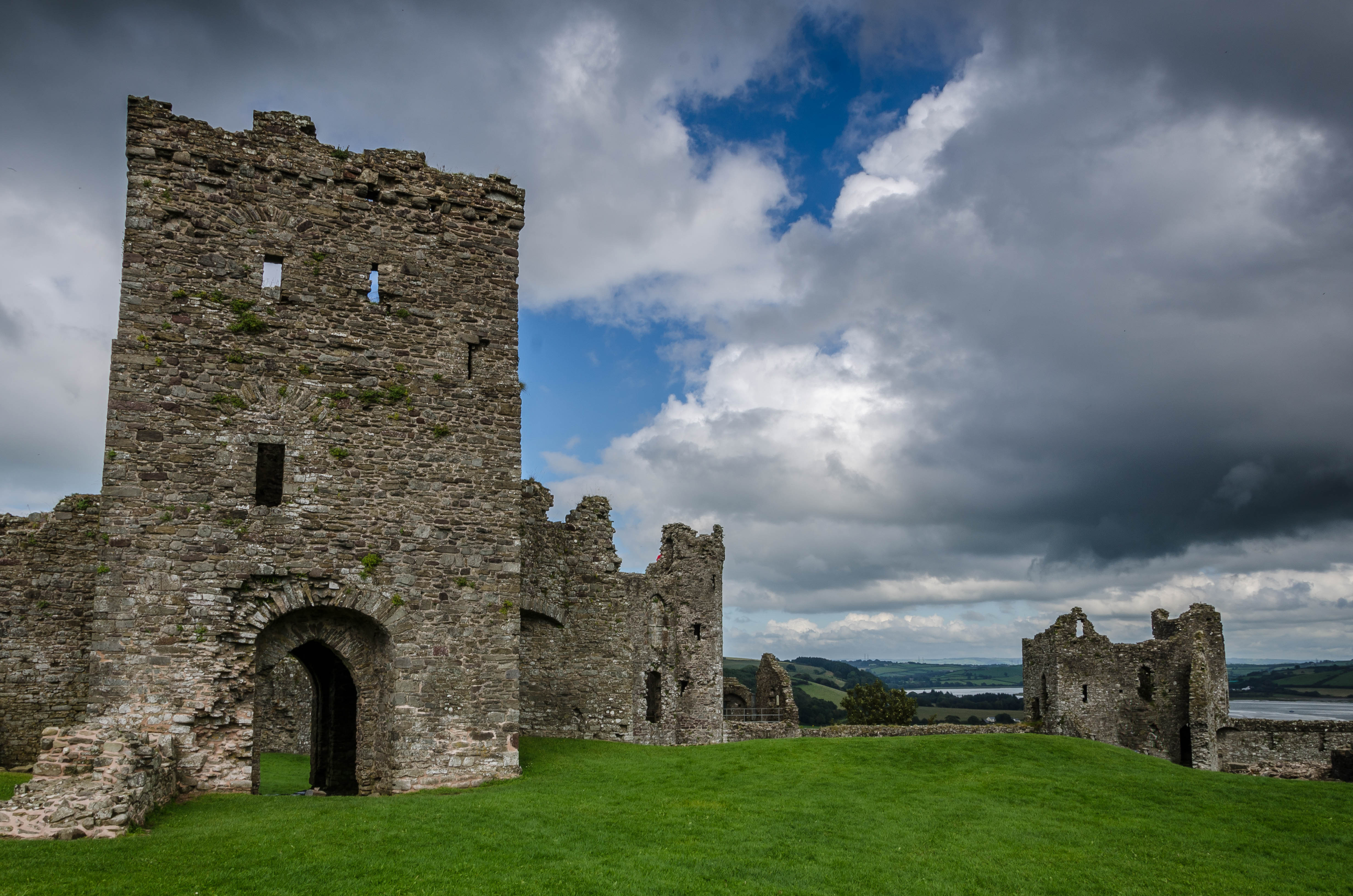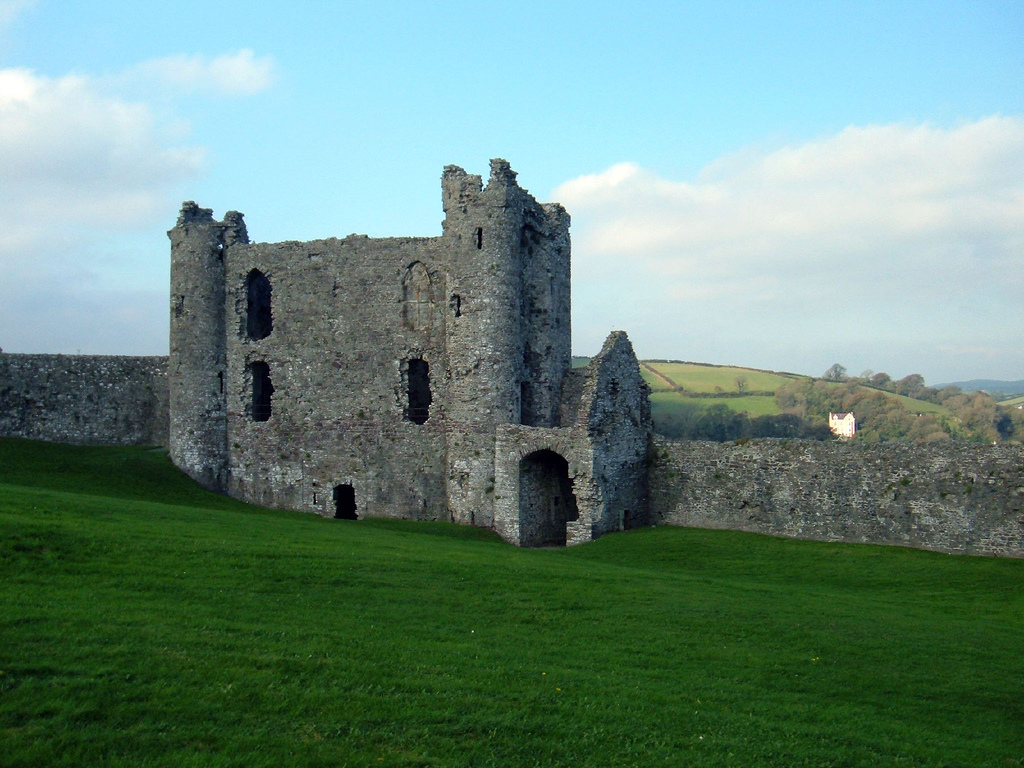Llansteffan Castle on:
[Wikipedia]
[Google]
[Amazon]
Llansteffan Castle ( cy, Castell Llansteffan) is a privately owned 


castle
A castle is a type of fortified structure built during the Middle Ages predominantly by the nobility or royalty and by military orders. Scholars debate the scope of the word ''castle'', but usually consider it to be the private fortified r ...
in Llansteffan
Llansteffan, is a village and a community situated on the south coast of Carmarthenshire, Wales, lying on the estuary of the River Tywi, south of Carmarthen.
Description
The community includes Llanybri and is bordered by the communities of: L ...
, Carmarthenshire
Carmarthenshire ( cy, Sir Gaerfyrddin; or informally ') is a county in the south-west of Wales. The three largest towns are Llanelli, Carmarthen and Ammanford. Carmarthen is the county town and administrative centre. The county is known as ...
, Wales
Wales ( cy, Cymru ) is a Countries of the United Kingdom, country that is part of the United Kingdom. It is bordered by England to the Wales–England border, east, the Irish Sea to the north and west, the Celtic Sea to the south west and the ...
, overlooking the River Tywi
The River Towy ( cy, Afon Tywi, ) is one of the longest rivers flowing entirely within Wales. Its total length is . It is noted for its sea trout and salmon fishing.
Route
The Towy rises within of the source of the River Teifi on the lower slo ...
estuary
An estuary is a partially enclosed coastal body of brackish water with one or more rivers or streams flowing into it, and with a free connection to the open sea. Estuaries form a transition zone between river environments and maritime environment ...
in Carmarthen Bay
Carmarthen Bay ( cy, Bae Caerfyrddin) is an inlet of the South Wales coast, including notable beaches such as Pendine Sands and Cefn Sidan sands. Carmarthen Bay is partially within the Pembrokeshire Coast National Park. The Joint Nature Conserva ...
.



Iron Age
The castle sits on a much olderIron Age
The Iron Age is the final epoch of the three-age division of the prehistory and protohistory of humanity. It was preceded by the Stone Age (Paleolithic, Mesolithic, Neolithic) and the Bronze Age (Chalcolithic). The concept has been mostly appl ...
promontory fort
A promontory fort is a defensive structure located above a steep cliff, often only connected to the mainland by a small neck of land, thus using the topography to reduce the ramparts needed. Although their dating is problematic, most seem to da ...
, proving Llansteffan has been inhabited for several millennia. The hill where the castle stands commands the River Tywi
The River Towy ( cy, Afon Tywi, ) is one of the longest rivers flowing entirely within Wales. Its total length is . It is noted for its sea trout and salmon fishing.
Route
The Towy rises within of the source of the River Teifi on the lower slo ...
estuary. The hill would have been stripped of trees so that foot soldiers were vulnerable to attack by archers. The original earthworks can still be seen and were used as part of the modern castle's defence system—the castle proper rests within the earthwork rings.
Conquest of West Wales
The castle was built by theNormans
The Normans (Norman language, Norman: ''Normaunds''; french: Normands; la, Nortmanni/Normanni) were a population arising in the medieval Duchy of Normandy from the intermingling between Norsemen, Norse Viking settlers and indigenous West Fran ...
after 1100 as part of their invasion of Wales and granted to the Marmion family before passing to the Camvilles through marriage.
It was captured by Maredudd ap Gruffydd
Maredudd ap Gruffydd (1131–1155) was a prince of the kingdom of Deheubarth in Southwest Wales.
Maredudd was the fifth of six sons of Gruffydd ap Rhys, and the third of four by Gwenllian ferch Gruffydd;Cadw, Welsh Government (Crown Copyright), ...
in 1146 against the forces of Maurice FitzGerald, Lord of Lanstephan
Maurice FitzGerald, Lord of Maynooth, Naas, and Llanstephan (born: almost certainly not at Windsor Castle, more likely Carew in Wales c.1105 – September c.1176 Wexford, Ireland. He was a medieval Anglo-Norman baron and a major figure in the N ...
and his brother William FitzGerald, Lord of Emlyn who were the leading Norman
Norman or Normans may refer to:
Ethnic and cultural identity
* The Normans, a people partly descended from Norse Vikings who settled in the territory of Normandy in France in the 10th and 11th centuries
** People or things connected with the Norm ...
settlers of the region. The castle was retaken by the Normans in 1158. Llywelyn the Great
Llywelyn the Great ( cy, Llywelyn Fawr, ; full name Llywelyn mab Iorwerth; c. 117311 April 1240) was a King of Gwynedd in north Wales and eventually " Prince of the Welsh" (in 1228) and "Prince of Wales" (in 1240). By a combination of war and d ...
recaptured the castle for the Welsh
Welsh may refer to:
Related to Wales
* Welsh, referring or related to Wales
* Welsh language, a Brittonic Celtic language spoken in Wales
* Welsh people
People
* Welsh (surname)
* Sometimes used as a synonym for the ancient Britons (Celtic peop ...
in 1215 and taken back by the Camville family sometime after 1223. The castle fell to Llywelyn ap Gruffudd
Llywelyn ap Gruffudd (c. 1223 – 11 December 1282), sometimes written as Llywelyn ap Gruffydd, also known as Llywelyn the Last ( cy, Llywelyn Ein Llyw Olaf, lit=Llywelyn, Our Last Leader), was the native Prince of Wales ( la, Princeps Wall ...
in 1257 but returned to the Camvilles by the 1260s.
By 1367, it was described as in a poor state.
Owain Glyndŵr
Thecastle
A castle is a type of fortified structure built during the Middle Ages predominantly by the nobility or royalty and by military orders. Scholars debate the scope of the word ''castle'', but usually consider it to be the private fortified r ...
was captured twice by the forces of Owain Glyndŵr
Owain ap Gruffydd (), commonly known as Owain Glyndŵr or Glyn Dŵr (, anglicised as Owen Glendower), was a Welsh leader, soldier and military commander who led a 15 year long Welsh War of Independence with the aim of ending English rule in Wa ...
in 1403 and c.1405. It was recaptured by Sir John Pennes in 1408. The castle was later granted to the Crown
A crown is a traditional form of head adornment, or hat, worn by monarchs as a symbol of their power and dignity. A crown is often, by extension, a symbol of the monarch's government or items endorsed by it. The word itself is used, partic ...
and the two-tower Gatehouse was converted into a residence.
Preservation
The castle, which is privately owned, is under a deed of guardianship withCadw
(, a Welsh verbal noun meaning "keeping/preserving") is the historic environment service of the Welsh Government and part of the Tourism and Culture group. works to protect the historic buildings and structures, the landscapes and heritage s ...
.
See also
*List of hillforts in Wales
This is a list of hillforts in Wales.
Anglesey
*Bwrdd Arthur, Din Sylwy (Bwrdd Arthur) (), contour fort
*Caer Idris Hillfort (), promontory fort
*Caer y Twr (), partial contour fort
*Dinas Gynfor (), promontory fort
*Dinas Porth Ruffydd (), p ...
References